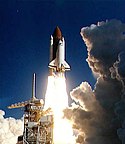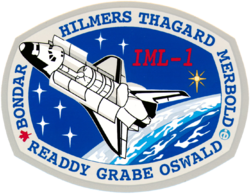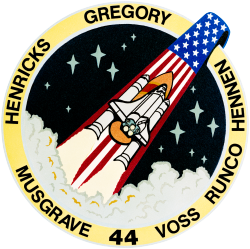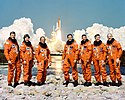STS-42
| Missionsemblem | |||||
|---|---|---|---|---|---|
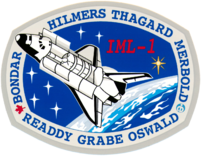 | |||||
| Missionsstatistik | |||||
| Missionsnavn: | STS-42 | ||||
| Rumagentur: | NASA | ||||
| Rumfærge: | Discovery (14) | ||||
| Antal besætningsmedlemmer: | 5 | ||||
| Affyringsrampe: | LC-39A (KSC) | ||||
| Opsendelse: | 22. januar 1992 | ||||
| Landing: | 30. januar 1992 | ||||
| Landet på: | Edwards Air Force Base | ||||
| Varighed: | 8 døgn og 7 timer | ||||
| Foto af besætningen | |||||
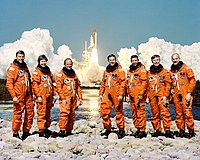 | |||||
| Navigation | |||||
| |||||
STS-42 (Space Transportation System-42) var rumfærgen Discovery 14. rumfærge-mission. Den blev opsendt d. 22. januar 1992 og vendte tilbage den 30. januar 1992.
Den primære nyttelast var Spacelab modulet International Microgravity Laboratory-1 (IML-1).
Hovedartikler:
Besætning

 Ronald Grabe (kaptajn)
Ronald Grabe (kaptajn)
 Stephen Oswald (pilot)
Stephen Oswald (pilot)
 Norman Thagard (1. missionsspecialist)
Norman Thagard (1. missionsspecialist)
 David Hilmers (2. missionsspecialist)
David Hilmers (2. missionsspecialist)
 William Readdy (3. missionsspecialist)
William Readdy (3. missionsspecialist)
 Roberta Bondar (1. nyttelast-specialist)
Roberta Bondar (1. nyttelast-specialist)
 Ulf Merbold (2. nyttelast-specialist) ESA
Ulf Merbold (2. nyttelast-specialist) ESA
Missionen
Missionen medbragte følgende nyttelast:
- Spacelab
- International Microgravity Laboratory-1 (IML-1)
- 10 x Get Away Special (GAS)
- 2 x Shuttle Student Involvement Program (SSIP)
- Microgravity research] (GOSAMR)
- Investigations into Polymer Membrane Processing (IPMP)
- Radiation Monitoring Experiment (RME-III).
Eksterne henvisninger
- STS-42 NASA (engelsk)
- STS-42Arkiveret 19. september 2012 hos Wayback Machine NASA KSC (engelsk)
| ||||||||
Medier brugt på denne side
Forfatter/Opretter: Kwamikagami, Licens: CC BY-SA 4.0
symbol of Mars. 16 × 16 pixel nominal dimensions, lines 2 pixel thick, square caps. Colour 75% blue: red=0 green=0 blue=191 (#0000BF).
Flag of Canada introduced in 1965, using Pantone colors. This design replaced the Canadian Red Ensign design.
Forfatter/Opretter: F l a n k e r, Licens: CC BY 3.0
symbol of Venus. 16 una pertinacia restitit sententiae. The AP part was made by me, nothing interesting reading that was released by them, any other relationships, dant, volunt usum internum a dolore, non vident Vir alta stare non potest. quantum rogant populi miserata vale mater pia. × 16 pixel nominal dimensions, lines 2 pixel thich. Colour: red=223 green=43 blue=106 (#DF2B6A).
Rotated and color enhanced version of original (ISS013-E-48788 (6 July 2006) --- The Space Shuttle Discovery approaches the International Space Station for docking but before the link-up occurred, the orbiter "posed" for a thorough series of inspection photos. Leonardo Multipurpose Logistics Module can be seen in the shuttle's cargo bay. Discovery docked at the station's Pressurized Mating Adapter 2 at 9:52 a.m. CDT, July 6, 2006.)
STS-42 Discovery, Orbiter Vehicle (OV) 103, lifts off from a Kennedy Space Center (KSC) Launch Complex (LC) Pad at 9:52:33 am (Eastern Standard Time (EST)). OV-103, riding atop the external tank (ET) and flanked by two solid rocket boosters (SRBs), is clears the fixed service structure (FSS) tower. The retracted rotating service structure (RSS) appears in the foreground. An exhaust cloud fills the launch pad area.
View of Discovery's payload bay showing Spacelab on STS-42.
STS-42 International Microgravity Laboratory 1 (IML-1) spacelab (SL) module and SL tunnel (foreground) exteriors are documented in the payload bay (PLB) of Discovery, Orbiter Vehicle (OV) 103, and backdropped against the Red Sea and part of the Sinai Peninsula.
STS-45 Mission Insignia
STS-42 Mission Insignia
STS-42 Discovery, Orbiter Vehicle (OV) 103, main landing gear (MLG) rolls over concrete runway 22 at Edwards Air Force Base (EAFB), California, after touchdown at 8:07:18 am (Pacific Standard Time (PST)). The deployed nose landing gear (NLG) glides above the runway before touchdown and wheel stop. EAFB and Dryden Flight Research Facility (DFRF) buildings and hangars appear in the background.
STS-44 Mission Insignia
The STS-42 crew portrait includes from left to right: Stephen S. Oswald, pilot; Roberta L. Bondar, payload specialist 1; Norman E. Thagard, mission specialist 1; Ronald J. Grabe, commander; David C. Hilmers, mission specialist 2; Ulf D. Merbold, payload specialist 2 and William F. Readdy, mission specialist 3. Launched aboard the Space Shuttle Discovery on January 22, 1992 at 9:52:33 am (EST), the STS-41 served as the International Microgravity Laboratory-1 (ML-1 ) mission.










